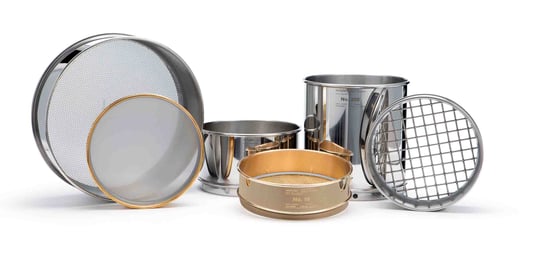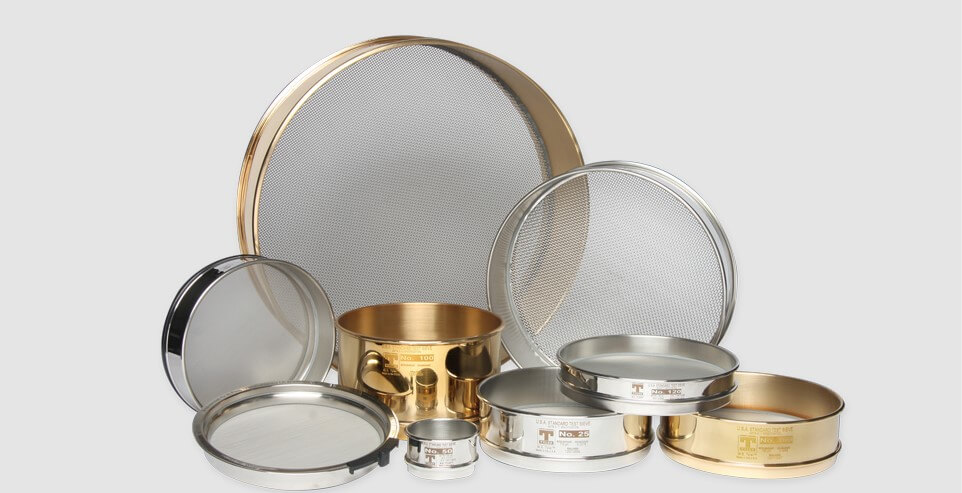Advantech Test Sieves vs. W.S. Tyler Test Sieves
Test sieves have helped countless industries screen particles of various sizes for centuries. Whether by hand sieving or through the use of a sieve shaker, test sieve analysis has gained a reputation of reliability.
Because there are so many test sieve manufacturers throughout the particle analysis industry, test sieves are a dime a dozen and come in various form factors. For this, it can sometimes be difficult to distinguish the differences between sieves, such as Advantech test sieves and W.S. Tyler test sieves.
W.S. Tyler has manufactured, handled, and certified an endless amount of test sieves over the decades and understands that finding the designing the right sieve stack is possible the most crucial step to establishing accurate and repeatable results.
To help you identify the similarities and differences between Advantech and W.S. Tyler Sieves, we designed this article to provide insight into:
- The technical differences between the two test sieve variants
- The compatibility each one has with one another
- The cost differences between the two test sieve variants
How Do Advantech Sieves and W.S. Tyler Sieves Compare?
When it comes to performance, Advantech sieves and W.S. Tyler share little to no differences. That said, there are some cosmetic differences that you should be aware of.
These differences are alloy used, the sealing agent used, the sieve labeling, and the finish applied to the frame.
Alloy
Advantech brass test sieves are constructed using yellow brass, whereas W.S. Tyler brass test sieves are constructed using a red brass. Other than the physical color of the sieves, there is no difference.
This includes both the durability and performance of the sieve.
The same goes for stainless steel. Advantech uses 304 stainless steel to construct their sieves, while W.S. Tyler uses 305 stainless steel.

That said, with Advantech's 304 stainless material, an extra annealing step is applied to soften the metal when forming the sieve. W.S. Tyler doesn't apply this step as 305 stainless steel delivers the flexibility needed to form the test sieves without the need for such heat treatments.
Again, this has no impact on the sieve's performance.
Sieve Screen
There is no difference seen when it comes to the mesh screens used in the sieves. They both meet ASTM E11 and ISO 3310 standards, as a test sieve should.
The only difference was the supplier in which the mesh came from.
Sealing Agent
W.S. Tyler uses a gray, two-part epoxy to seal the crease where the mesh meets the frame and prevent particles from getting lodged in the crease. Advantech uses a clear UV glue.
Both sealing agents perform the same function, with one not being better than the other.
Sieve Labeling
You will find that Advantech is still using pins stamped nameplates to record the serial number and mesh of the sieve. W.S. Tyler uses a laser etching technique that is more permanent.
Frame Finish
W.S. Tyler buffs its test sieves to create a lustrous gloss finish to the frames. Advantech uses a brushing technique to create more of a matte finish.
To that end, neither finish style affects how particles interact with the sieve's profile. The difference is purely cosmetic.
Can I Use Advantech Test Sieves With W.S. Tyler Test Sieves?
When it comes to form, fit, and function, both Advantech and W.S. Tyler sieves are the same. This means they are interchangeable in a sieve stack.
So an Advantech 8-inch sieve will stack on a W.S. Tyler 8-inch and vice versa.
It should be noted that Advantech sieves only come in 12 and 8-inch diameter variants, whereas W.S. Tyler produces 3-inch, 6-inch, 8-inch, 10-inch, 12-inch, 18-inch, 200-millimeter, 300-millimeter diameter sieves.
Advantech sieves are also limited to the standard ISO and ASTM mesh sizes. W.S. Tyler sieves feature the full range of ASTM and ISO sizes.
How Do Advantech Sieves and W.S. Tyler Sieves Compare in Price?
There is little to no difference in cost when comparing Advantech sieves to W.S. Tyler sieves. That said, the overall cost of both sieves comes down to the frame diameter, frame and mesh alloy, sieve height, and mesh size.
Using an 8-inch sieve as a reference, the average cost of a sieve that's #80 mesh and coarser is $60-$70, the average cost of a sieve that's #100 mesh to 200 mesh is $60 to $80, and the average cost of a sieve that's #230 to #635 mesh is $90 to $500. To that end, brass sieves typically cost more than stainless steel sieves.
For more information on the cost of a test sieve, read the following article:
Which Test Sieves Should I Use: Brass or Stainless Steel?
Advantech and W.S. Tyler test sieve are two test sieve variants that are very similar in cost and performance. In fact, you can stack new W.S. Tyler sieves onto your existing Advantech sieves without seeing any differences in results.
You will only notice slight cosmetic differences.
That said, to truly design a sieve stack that fits your needs, you must determine whether brass or stainless steel should be used to construct the frame and mesh of your sieves. While there are no performance differences between Advantech and W.S. Tyler, certain particles will react differently depending on the alloy of the sieve and sieve mesh.
W.S. Tyler has led the particle analysis industry in test sieve production and has worked with dozens of test sieve variants along the way.
This enabled us to write the following article to help you establish which test sieve variant will work best for you:
About Ronnie Brown
Ronnie is the Content Writer for W.S. Tyler and has four years of experience as a professional writer. He strives to expand his knowledge on all things particle analysis and woven wire mesh to leverage his exceptional writing and graphic design skills, creating a one-of-a-kind experience for customers.



